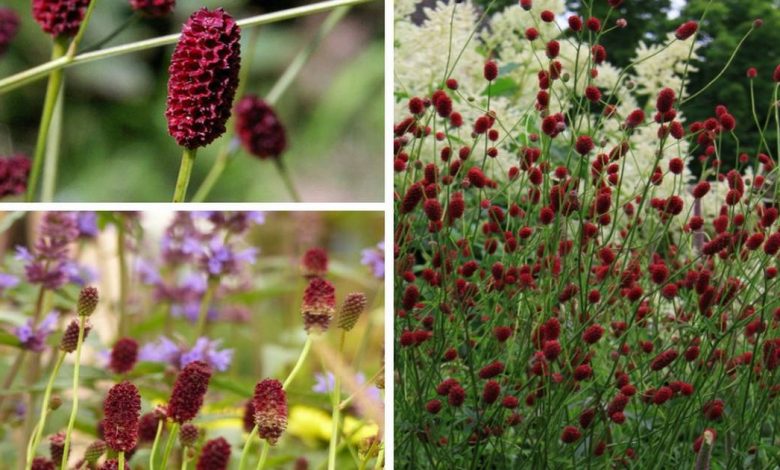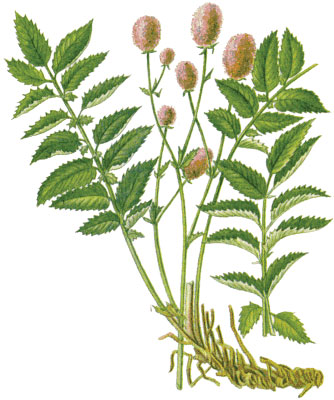Burnet, Sanguisorba officinalis L. – as used in official and traditional medicine

Perennial herb up to 100-120 cm, families rozotsvetnыh (Rosaceae). From drug to use the rhizomes and roots of the plant.
Sanguisorba officinalis, commonly known as the great burnet, is a medicinal plant with a long history of use in traditional Chinese and Western medicine.
Native to Europe and Asia, it belongs to the rose family and grows in moist and shady meadows. stems, leaves, The fruits and roots of the plant have been used for centuries as an herbal remedy for various ailments., including skin diseases, bleeding disorders and digestive problems.
This article will discuss the chemical composition, Pharmacological properties, medicinal use, as well as dosage forms and doses of Sanguisorba officinalis.

Burnet – chemical composition
The rhizomes and roots of the plant contain tannins pirogallovoy group, Gauls, and oxalic acid ellagic, pigments, starch, traces of essential oil, gallotanidy, ascorbic acid, carotene, saponin, sangvisorbin and sterols.
Sanguisorba officinalis contains various compounds, that contribute to its medicinal properties. These include flavonoids, tannins, sterols and saponins.
Flavonoids contribute the most to the medicinal properties of the plant and include quercetin, rhobinine, which, myricetin and rutin.
Tannins are astringent compounds, which can reduce inflammation and swelling.
Sterols are plant compounds, having anti-inflammatory, antifungal and antibacterial properties.
Finally, saponins are chemical compounds, which can increase the absorption of nutrients from the intestines.
Burnet – Pharmacological properties
The high content of tannins makes astringent, anti-inflammatory and hemostatic effect of herbal medicines burnet. It has been experimentally proved, extract from the roots of plants when applied topically anti-inflammatory and vasoconstrictor properties, and when intragastric administration inhibits peristalsis and reduces the muscles of the uterus.
Burnet – medical applications
Burnet used in diseases, accompanied by bleeding (hemoptysis in patients with pulmonary tuberculosis, heavy menstruation, Stomach, hemorrhoidal, uterine bleeding). As hemostatic agents burnet more effective in combination with other agents, having similar properties. Topical preparations burnet used for wound healing, cuts and abrasions.
Drugs prescribed for burnet enterocolitis, diarrhea of various etiologies. As an anti-inflammatory agent decoction or liquid extract of the plant is used for angina, gingivitis and stomatitis, in certain inflammatory respiratory diseases.
Burnet officinalis is most commonly used as an herbal remedy for skin conditions., especially for eczema and psoriasis. It is believed, that it reduces inflammation and itching and can be applied topically as an ointment or ointment. Besides, the plant is also used to treat bleeding disorders, such as excessive menstrual bleeding and nosebleeds. The plant's anticoagulant properties help reduce excessive bleeding..
Sanguisorba officinalis is also used to treat digestive problems., such as stomach ulcers and diarrhea. It is believed, that it reduces inflammation in the gastrointestinal tract and is used to treat abdominal pain and nausea. The plant is also used to treat respiratory infections., such as bronchitis and pneumonia.
There is information about clinical use and therapeutic efficacy of the decoction of the root plant in cholecystitis, trihomonadnyh obesity, chronic dysentery, and also in various pathologies intestine, accompanied by flatulence. It is now established, that the preparations of the roots of burnet have significant activity Phytoncidic, that allows you to assign them with certain infectious diseases of the gastrointestinal tract. At therapeutic doses, the drug burnet side effects do not give.
Burnet – Dosage Forms, Dosing and Administration
Liquid extract of burnet on 70 % alcohol appoint 30-50 drops 3-4 times a day.
A decoction of the roots and rhizomes burnet: 6 g (2 tablespoons) raw material is placed in an enamel bowl, Pour 200 ml (1 glass) hot boiled water, capped and heated in boiling water (in a water bath) 30 m, cooled at room temperature 10 m, filter. The remaining raw materials squeeze. The volume of the resulting broth bring boiled water to 200 ml. The prepared broth is stored in a cool place no more 2 d.
Take 1 tablespoon 5-6 times daily after meals as an astringent and styptic.
The raw material stored in a dry, cool place.
Burnet officinalis is a medicinal plant with a long history of use in traditional Chinese and Western medicine.. It is believed, that it has anti-inflammatory, antibacterial, antifungal, antispasmodic and astringent properties. The plant is available in various dosage forms., and it can be taken as a tea, tinctures, ointments or ointments. Dose varies depending on the condition, which is being treated, and human health. As always, it is important to consult a doctor, before taking any herbal supplements.
